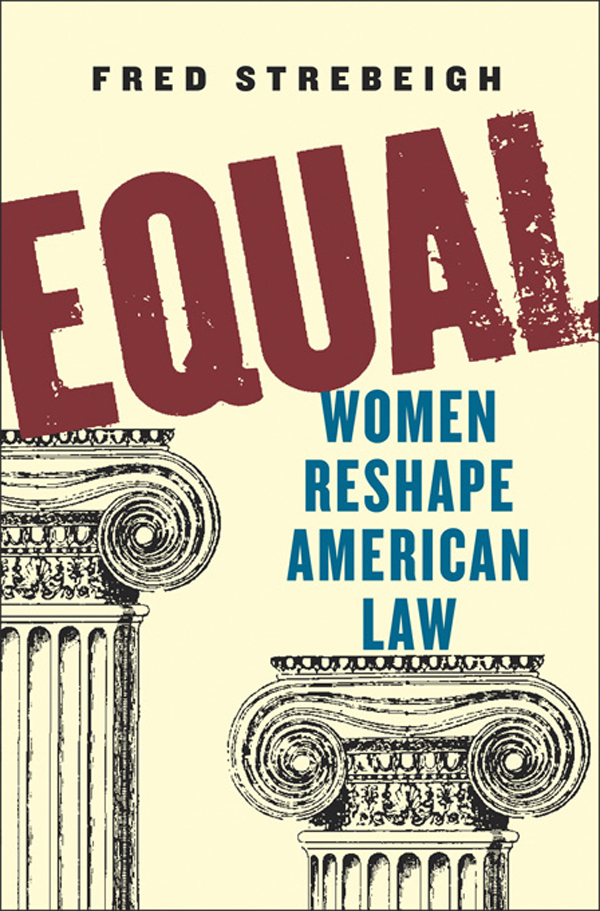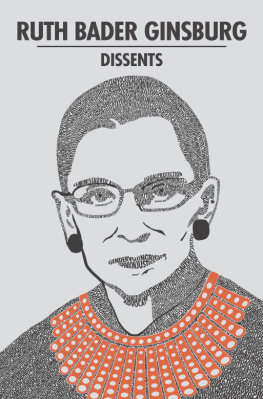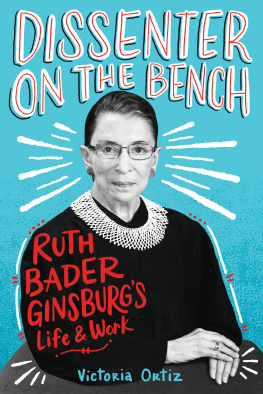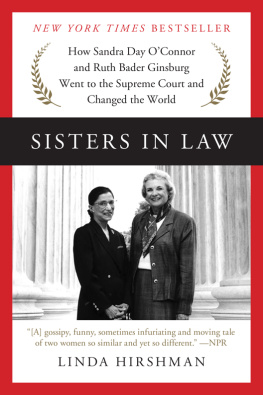
EQUAL

Women Reshape American Law
FRED STREBEIGH
W. W. NORTON & COMPANY
NEW YORK LONDON
To women shaping law
CONTENTS

5: What Happened to Sally Armendariz Could Not Happen
to a Man
PROLOGUE

Toward Equality
(1968)
a woman who wanted to become an American lawyer, the time before 1968 was a time of inequality. If you entered Harvard Law School before 1950, for example, you were male. Although some American law schools had admitted a trickle of women for decades, prior to 1950 Harvard practiced perfect discrimination: no women need apply.
By 1967, the proportion of women in the nations law schools had reached only about 5 percent. 1968 changed American law. The U.S. government announced plans to take away mens draft exemptions for attending law school. Harvard feared the worst. Testifying before Congress to oppose the change, President Nathan Pusey of Harvard predicted that his law schools entering class of 540 would be reduced by close to a half. Harvard Law might stay full only by compromising on quality or something. Moments later, Congressman John Erlenborn tried to help Harvards president spell out that compromise. Graduate programs like Harvards, the congressman said, seemed pushed toward a policy of admitting women, the halt, and the lame.
To that list, Harvards president added the foreign born. The congressman repeated: And the foreign. Half of Harvard Law need filling, they seemed to predict with a sniff of xenophobia, by women and others they viewed as outsiders.
The prediction to Congress proved partly true. Low on men, law schools opened the gates of the law to women. In 1968, the number of women entering American law schools jumped by 50 percent. Within a decade, the number of women entering law schools increased 1,000 percent, from fewer than 1,200 in 1967 to almost 12,000 in 1977. In 2001, law schools admitted 22,000 women, more than 49 percent of all entering law students. Women made the fastest advance in the history of Americas elite professions.
As women entered the law, the law resisted. Judges would not hire women. Law firms asserted a right to discriminate against women. Judges permitted discrimination against pregnant women. Courts viewed workplace harassment as, one judge said, a game played by the male superiors.
Young women lawyers, armed with new degrees, began to tackle the old ways of male-shaped law. The law began to change as law sometimes doesone story at a time, one case at a time, and one precedent at a time. Women lawyers went to court to tell the stories of Paula Wiesenfeld in 1972 (constitutional discrimination), Sally Armendariz in 1972 (pregnancy discrimination), Diane Blank in 1975 (employment discrimination), Mechelle Vinson in 1978 (sexual harassment), Christy Brzonkala in 1994 (violence against women), and many other women along the way. This book, drawing on interviews with and documents from participants in those cases, tells the stories behind the cases that propelled American law toward equality. And it tells tales of resistance from on high.
Part One

SCRUTINY
(19701975)

The Story of Paula Wiesenfeld
in 1972 a new professor at Columbia Law School, Ruth Bader Ginsburg, heard the story of Paula and Stephen Wiesenfeld. Immediately she knew that their sad tale offered the legal case she needed. By taking their story to the Supreme Court of the United States, she could accomplish her greatest professional goal: to eliminate what she called gender lines in the law. Ginsburg in the early 1970s was making the most profound attack on sexist law in the history of the American legal system.
The Wiesenfelds story began as a romance. When Paula Polatschek first met Stephen Wiesenfeld, she had the looks of a Disney Mouseketeer. She had mahogany eyes and black hair with a tint of persimmon, turned up at her shoulders in a slight flip that almost matched the upturn of the corners of her mouth when she smileda sassy smile that formed her cheeks into hemispheres, like half-apples.
Stephen Wiesenfeld was slender with a hawklike nose and a reddish beard and a madcap look that made him resemble a young Gene Wilder. They had met in late 1969, and soon they were spending much of their time together, entertaining friends, fooling around, and photographing their antics. Stephen lived and worked in New Jersey; Paula lived in Manhattan and taught in White Plains, just north of New York City. After Paulas teaching ended in the spring of 1970, drove down to New Jersey and stayed with Stephen through the summer.
As fall approached, with a couple of weeks remaining before school would start, Paula asked Stephen if she should go back to her apartment in Manhattan. The conversation was light as usual, more fooling than planning.
Paula asked, What if I get a job in New Jersey? Stephen knew Paula hadnt been looking for jobs. Mostly fooling, he proposed a sort of bet: If you can get a job in New Jersey, we can get married. It was a bet he supposed he couldnt lose.
What Stephen couldnt fully know was how good a teacher Paula was, or how much her credentials put her in demand. As well as her undergraduate degree in math, she had a masters in education and had begun studying for her PhD in education. Within a week, Paula had two job offers. She took a job teaching mathematics at Edison High School, right in Stephens hometown. They married in November.
Soon they were building a life together and, to go with it, a dream house. It was larger than most of their friends houses, three thousand square feet, big enough that Stephen, in a moment of euphoria, was able to describe it as a fourteen-room housea number that came from counting every walled-in space, including the entry hall and all the bathrooms. But whatever its room-count, it was theirsbuilt on land they chose, to their specifications. And Stephen, being something of a perfectionist, played a hands-on role. Many evenings, after the builders had left, he would go to the house to scout for substandard lumber or workmanship. If a piece of work fell far below his standards, he would simply remove itleaving the builders to do the job better the next day. When the builders finished, the price tag was $32,000 and the job was all that Paula and Stephen had hoped. On the day they moved in, Paula said to Stephen, I never dreamed Id live in a house like this. For years he would remember how proud it made him to help Paula attain her dream.
At about the time Stephen and Paula moved into their new home, they discovered Paula was pregnant. So they began wallpapering a babys room, choosing a pattern with blue elephants and pink camels and green palm trees. As they prepared the walls, they painted messages to each other like I love you and Stephen loves Paulasignals to the future about their love in the present.
As they went to doctors and childbirth classes, they made another preparation: how to organize their working lives. Paulas teaching was earning more money than Stephens computer consulting, and more to the point, she had planned some demanding years. She wanted her PhD, and she needed it soon in order to meet her goal of becoming a school administrator and, if possible, a school principal.
Next page









